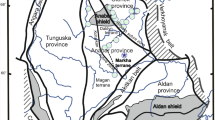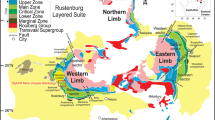Abstract
In this paper, the authors have proposed two distinct series of petrogenesis and mineralization: Series I and Series II. Series I (the Nanling Series) has a sequence of petrogenesis and mineralization: monzonitic granite or granodiorite → biotite granite → leuco-granite → granoporphyry or quartz porphyry → intermediate-basic dikes; REE → Nb, Ta (Li, Rb, Cs), Be, Sn, W, Mo, Bi, As → Cu, Zn, Pb → Sb, Hg, U. Series II (the Yangtze Series): Pyroxene diorite (or gabbro) → diorite or quartz diorite → granodiorite (quartz monzonite or monzonitic granite → granite → K-feldspar granite → granoporphyry or quartz porphyry (syenitic porphyry or quartz syenitic porphyry) → intermediate-basic dikes; Fe → Cu(Au) → Mo(W) → Zn, Pb → Pb (Ag).
Obvious differences have been recognized between Series I and II. As for Series II, the bulk composition is close to that of andesite. Relatively high temperatures of formation (980°–1,140°C) petrochemical enrichment in Mg and Ca, the composition of biotite characterized by high magnesium, assemblages of accessory minerals (magnetite-sphene-apatite or magnetite-ilmenite-REE-rich zireon), trace elements predominated by Cl and Sr with ΣCe>ΣY in the rocks and accessory minerals, relatively high σEu(0.74–0.99) without depletion, δ18O<10‰ δ34S close to that of meteorite sulfur, relatively high content of platinum metals (>10 times) characteristic of mantle origin, vory low87Sr/86Sr (0.7036–0.7085) and the occurrence of intermediate-basic dikes (similar to basaltic composition) in the final evolutionary stage are sufficiently enough to show that Series II has a material source in the lower crust or in the upper mantle. The fact that87Sr/86Sr>0.7037 in most cases implies a partial incorporation of crust materials. As for Series I, the bulk composition is consistent with that of normal granites. Relatively low temperatures of formation (600°–680°C), chemical composition noted for high SiO2 and K2O, complicated accessory mineralogy and assemblages (magnetiteilmenite-zircon, or monazite-xenotime-zircon), biotite with high content of iron, trace elements predominated by F, Li, Rb (Cs) and Be, relatively low δEu with distinct depletion, δ18O>10‰ greatly varying δ34S, low content of platinum metals typical of mantle derivation, high87Sr/86Sr (0.7112–0.7360), in conjunction with the consideration of mineralizations of REE, Nb, Ta, Sn, Be, W, Bi, etc. of crust origin, indicate that the continental crust is the main material source for Series I. The possibility, however, cannot be ruled out that a small amount of upper mantle-derived material took part in this process, as has been indicated by lower87Sr/86Sr (≈0.7100), part of δ34S close to that of meteorite sulfur and the occurrence of intermediate-basic dikes (similar to basalts in composition) as the end products of magmatic evolution.
It is of interest to note that granitoid rocks of these two series in southeast China show considerable dissimilarities with those in Japan and Australia in87Sr/86Sr, δ18O and δ34S.
Similar content being viewed by others
References
Isotope Laboratory of the Institute of Geochemistry, Academia Sinica and Isotopic Dating Laboratory of the Hubei Institute of Geoscience, Geochimica, 2 (1972), 119–134.
Institute of Geochemistry, Academia Sinica, Geochemistry of Granites in South China, Science Press (1979), 76–80.
Wang, L. K. et al. Mining Geol. Spec. Issue, 8 (1980), 29–38.
Wang, L. K. et al., Geochimica, 3 (1981), 281–292.
Chappell, B. W. et al., Pacific Geology, 8 (1974), 173–174.
Ishihara, S. Mining Geol.,27 (1977), 293–305.
Wang Junwen et al., Geochimica, 3 (1981), 242–246.
G. Faul et al., Geology of Sr Isotopes, Science Press (Chinese version), 1975, 58–62.
Takahashi, M. et al., Mining Geol. Spec. Issue, 8 (1980), 13–28.
Taylor, H. P. Jr. Contrib. Mineral. Petrol., 19 (1968), 1–17.
Yun Hanhui et al., Geology and Exploration, 8 (1980), 1–4.
Yang Fengjun, Scientia Geologica Sinica, 3 (1966), 217–225.
Coleman, M. L., Jour. Geol. Soc., London, 133 (1977), 593–608.
Author information
Authors and Affiliations
Rights and permissions
About this article
Cite this article
Wang, L., Zhu, W. & Zhang, S. The evolution of two petrogenesis-mineralization series of granites in Southern China. Geochemistry 3, 1–13 (1984). https://doi.org/10.1007/BF03180125
Issue Date:
DOI: https://doi.org/10.1007/BF03180125




